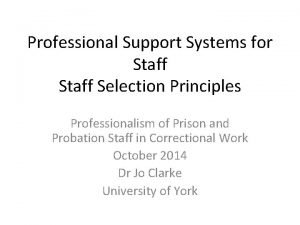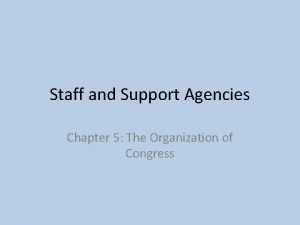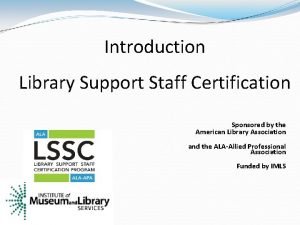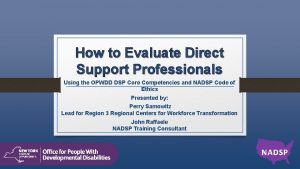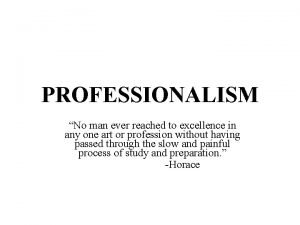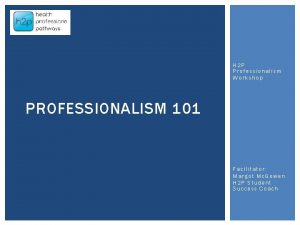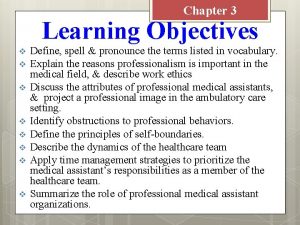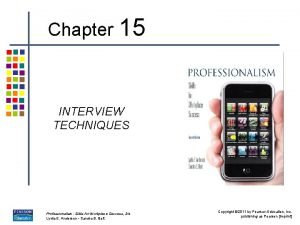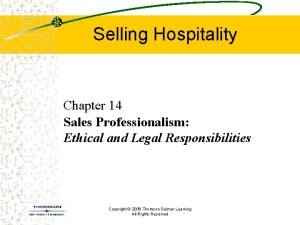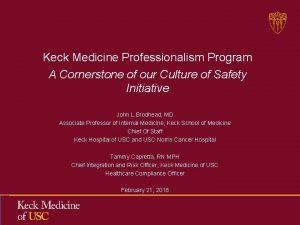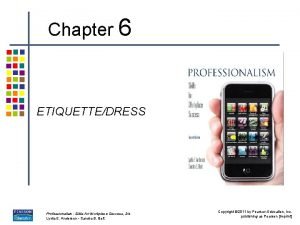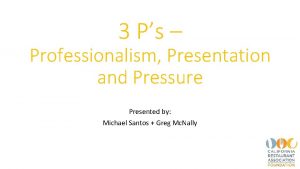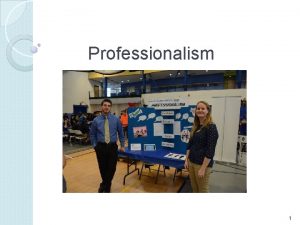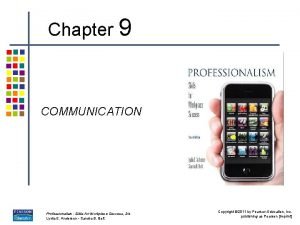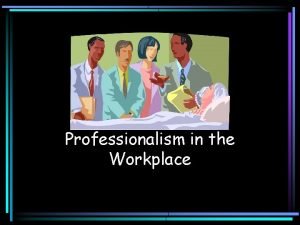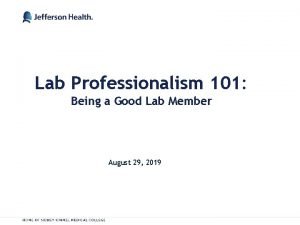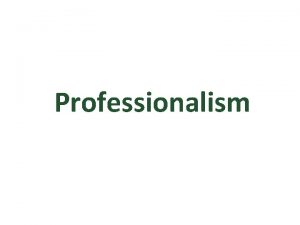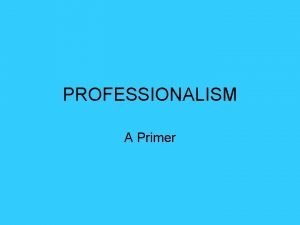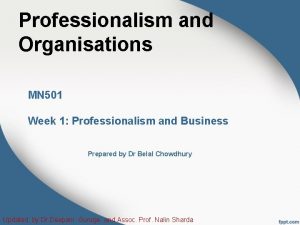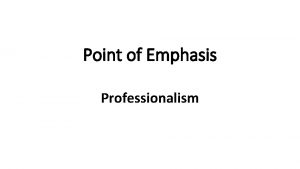Professional Support Systems for Staff Selection Principles Professionalism










































- Slides: 42

Professional Support Systems for Staff Selection Principles Professionalism of Prison and Probation Staff in Correctional Work October 2014 Dr Jo Clarke University of York

Setting the Scene A Critical Occupation One where there is high risk of exposure to traumatic events that may, under certain circumstances, exert critical impact on the psychological well-being of those within it (Paton & Violanti, 1996)










Resilience is… • …actually, not nearly as straight forward to define as we might think!! • Is it – A personality trait? – Measurable? – Stable over time? – Acquired? – Trainable? • “…relative resistance to environmental risk experiences, or the overcoming of stress or adversity. ” Rutter (2007).


Resilience • • Bounce-back-ability Hardiness Flexibility Thriving in the face of adversity Adjusting to demands Optimism Emotion control Using all your resources

Resilience (Paton et al, 2008) The capacity of organizations and individuals to draw upon their own individual, collective, and institutional resources and competencies in ways that allow them to render challenging events coherent, manageable and meaningful i. e. to cope with, adapt to, and develop from the demands, challenges and changes encountered as a result of working in a critical occupation

What’s good? • Kadambi and Truscott, 2003 – Protection of the public – Offender change and wellness – Connection to colleagues – Enjoyment of counselling – Offender specific change – Socially meaningful curiosity – Professional benefits

SPORE Final Conference The Stress Shield Model (Paton et al. , 2008)

SPORE Final Conference The Stress Shield Model (Paton, Violanti, Johnston, Burke, Clarke & Keenan, 2008) This model accounts for 47% of the variance in Job Satisfaction

SPORE Final Conference The Stress Shield Model (Paton, et al. , 2008) This model accounts for 27% of the variance in Adaptive Capacity

Model of Dynamic Adaptation (Clarke 2004) Positive Psychological Outcome Static Factors Critical Occupation Negative Psychological Outcome Stable Factors Dynamic Factors

About the factors • Static Factors – Factors that are fixed or unchanging or change in a highly predictable way, e. g. gender, qualifications, age • Stable Factors – Factors that are potentially changeable but relatively stable; factors that under normal circumstances only change slowly, e. g. coping style, perspective taking skills • Dynamic Factors – Factors that change rapidly and/or unpredictably, e. g. changes in organisational structure, events not under personal control (accident)

About the factors • Critical Occupation – This includes all the “on-the-job” type factors, such as types of unit/prisoners, colleague relationships, policies and procedures • Positive Psychological Outcome – Anything rewarding about the job, from working with a great team, to a previously highly aggressive prisoner getting through the day without hitting anyone! • Negative Psychological Outcome – Any cost, such as feeling irritable, tired, suspicious of others, anxious when alone, anxious around others etc

The Model of Dynamic Adaptation (Clarke, 2004) POSITIVE OUTCOME STATIC FACTORS CRITICAL OCCUPATION Age Organisational culture The Person STABLE FACTORS Coping style Personal trauma DYNAMIC FACTORS Protection of the public Offender change and wellness Connection to colleagues Enjoyment of counselling Offender specific change Socially meaningful curiosity Professional benefits NEGATIVE OUTCOME Disrupted schema Intrusive imagery Rumination Difficulty making decisions Heightened fear and anxiety Feelings of anger, guilt, frustration, disillusionment, depression, inadequacy Decreased sensitivity and dulling of emotion…

Model of Dynamic Adaptation (Clarke 2004) Intervention 2 Positive Psychological Outcome Static Factors Critical Occupation Negative Psychological Outcome Stable Factors Dynamic Factors Intervention 1 Intervention 3 Intervention 4

A Strategy to Enhance Resilience: Organisational Duty of Care • Preparation 1 (Intervention 1) – Selection (Skills, qualities, values) • Preparation 2 (Intervention 1 & 2) – Training (competence) • Practice (Intervention 2) – On the job support (supervision, debriefs, progression, early warning systems) • Post-Event-Recovery (Intervention 4) – Counselling, Trauma Disclosure

Model of Dynamic Adaptation (Clarke 2004) Positive Psychological Outcome Static Factors Critical Occupation Negative Psychological Outcome Stable Factors Dynamic Factors Intervention 1

Intervention 1: Preparation • Selection – Taking account of stable and static factors – Qualities and competencies for a particular role – Targeted psychometrics – Qualitative elements • Training – In psychological self-maintenance skills – Competencies for the role – Increase psychological resilience using simulation

Model of Dynamic Adaptation (Clarke 2004) Intervention 2 Static Factors Positive Psychological Outcome Critical Occupation Negative Psychological Outcome Stable Factors Dynamic Factors

Intervention 2: Organisational Practices • Organisations characterised by poor communication, red tape, lack of consultation have significantly higher symptoms of PTSD • Organisations characterised by an empowered workforce show signs of significantly more posttraumatic growth among staff (Paton, 2006) • Vulnerability to trauma symptoms increase through persistent use of established decision procedures, internal conflicts regarding responsibility, and a predisposition to protect the organisation from blame or criticism (Gist & Woodall, 2000)

Intervention 2: Solutions • Environmental Resilience – Impact – Choice – Meaning – Competence

Intervention 2: Peer and Social Support • 88% of therapists cite peer support as crucial (Jackson et al. , 1997) • Professional peers and co-workers highly valued support resource (Kadambi and Truscott, 2001) • Perception of peer support was a significant predictor of lower levels of psychological distress (Ennis and Horne, 2003)

But… • Some studies indicate peer support increased rather than decreased levels of stress (Grossi and Berg, 1991: Morrison et al. , 1992) • High levels of social support can have negative effects in mental health settings (Sandler and Barrera (1984) • Negative interactions can outweigh the beneficial effects of of social support (Fiore et al. , 1983) • Others suggest social support does not lead unconditionally to a positive effect (Peeters et al. , 1995) • There is little empirical evidence to to support the assertion that support from co-workers and supervisors is preventative (Digman and West, 1988)

Why? Most studies fail to incorporate assessment of individual differences such as coping style, attribution style and levels of perspective taking.

And another thing The perception of supportive behaviour appears to be dependent on who is providing it

Attrill (1995) • Co-therapists – covering shifts, discussing sessions • Specialist Staff – sharing specialist knowledge • Managerial Staff – Easing operational complexities, publicly backing the programme • Senior Managers – attending meetings and SOTP -related training • Poor administrative support from Senior Managers is associated with higher levels of exhaustion and worker disorientation (Garland, 2004)

Intervention 2: Supervision • Supervision and well-being: working with the individual in the High Risk context • Advantages – Provides 3 rd person perspective – Helps identify strengths and weaknesses – Helps gain insight – Identify issues of personal impact – Accountability – Ethical issues – Resolve tensions between stakeholders

Additional Interventions: • Developing skills of leaders and supervisors • Developing formal support networks within the team context • Develop a support infrastructure that responds, as far as possible, to individual needs over time

Model of Dynamic Adaptation (Clarke 2004) Positive Psychological Outcome Static Factors Critical Occupation Negative Psychological Outcome Stable Factors Dynamic Factors Intervention 3

Intervention 3: • Dynamic factors are very difficult to predict or account for • Staff experiencing a traumatic event report significantly more dissatisfaction with the organisation (Clarke, 2004) • Training that includes increased awareness of emotional and psychological processes of adaptation • Structuring expectations regarding the nature and likely effectiveness of the work • Reviewing work related material to enable informed consent

Model of Dynamic Adaptation (Clarke 2004) Positive Psychological Outcome Static Factors Critical Occupation Negative Psychological Outcome Stable Factors Dynamic Factors Intervention 4

Intervention 4 • Counselling or Debriefing – Counselling currently has good intuitive clinical and organisational appeal – Counselling can be effective in managing depression and anxiety – In the case of high risk jobs, this is rather like putting the ambulance at the bottom of the cliff – There is no empirical evidence that counselling is protective or preventative – More counselling significantly correlated with rumination and autonomy (Atkinson, 2005) – Increase in severity and chronicity of symptoms (Carlier, et al. , 1998) • Post Event Recovery environments

 Professional support system
Professional support system Integrity and professionalism
Integrity and professionalism Decision support systems and intelligent systems
Decision support systems and intelligent systems Principles of complex systems for systems engineering
Principles of complex systems for systems engineering Supporting agencies
Supporting agencies Library support staff certification
Library support staff certification Chapter 5 lesson 2 the structure of congress
Chapter 5 lesson 2 the structure of congress Balancing selection vs stabilizing selection
Balancing selection vs stabilizing selection Artificial selection vs natural selection
Artificial selection vs natural selection K selection r selection
K selection r selection Natural selection vs artificial selection
Natural selection vs artificial selection Difference between continuous and discontinuous variation
Difference between continuous and discontinuous variation Naturual selection
Naturual selection Logistic model of population growth
Logistic model of population growth Natural selection vs artificial selection
Natural selection vs artificial selection Two way selection and multiway selection in c
Two way selection and multiway selection in c Multiway selection in c
Multiway selection in c Mass selection and pure line selection
Mass selection and pure line selection Direct support professional performance evaluation
Direct support professional performance evaluation Professional support unit
Professional support unit No professionalism
No professionalism Domain 4: professional responsibilities examples
Domain 4: professional responsibilities examples Professionalism workshop
Professionalism workshop What are the 3 key elements of professionalism
What are the 3 key elements of professionalism Obstructions to professionalism
Obstructions to professionalism Professionalism skills for workplace success
Professionalism skills for workplace success Attributes of professionalism
Attributes of professionalism Professionalism conclusion
Professionalism conclusion Sales professionalism
Sales professionalism What is professionalism
What is professionalism Professionalism in project management
Professionalism in project management Professionalism conclusion
Professionalism conclusion Professionalism conclusion
Professionalism conclusion Gracious professionalism definition
Gracious professionalism definition Vanderbilt professionalism program
Vanderbilt professionalism program Ac61-98 plan of action
Ac61-98 plan of action Professionalism: skills for workplace success
Professionalism: skills for workplace success What are the three p's of professionalism
What are the three p's of professionalism Professionalism objectives
Professionalism objectives Professionalism skills for workplace success
Professionalism skills for workplace success Professionalism is judged against a set of
Professionalism is judged against a set of Professionalism in computing
Professionalism in computing Labarchives jefferson
Labarchives jefferson
